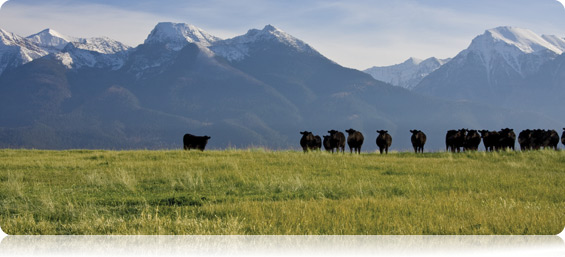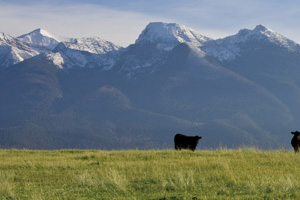
You may be surprised to learn that there’s more argument about the eco-friendliness of grass fed beef than you’d expect. The main reasons for this are that people are using different definitions of eco-friendly and measuring different aspects of the beef production process.
The Complicated Carbon Footprint Question
Many discussions of beef’s environmental impact at a global level focus on carbon footprint. This is probably due to the discovery that livestock accounts for a staggering 18 percent of global greenhouse gas emissions (Marshall, 2010).
The methane that the cattle themselves emit is part of the problem. According to a recent Australian study, “emissions from grass-fed cows were about 20 percent higher than grain-fed.” Grain is more easily digested by cattle, producing less gas. In addition, grain-fed animals also grow to market weight faster, so they’re emitting methane for less time (Marshall, 2010).
However, even if grass fed cattle do produce more methane, that isn’t the only consideration when deciding which feed method produces less greenhouse gasses in total.
As Michael Pollan (The Omnivores Dilemma) explains: “Much of the carbon footprint of beef comes from growing grain to feed the animals, which requires fossil-fuel-based fertilizers, pesticides, transportation” (Abend, 2010).
To put it another way,
Grasses are perennials…that means they grow back year after year and there’s not a lot of fuel used to produce the grasses…when you feed animals grain you really mean you’re feeding them corn and corn is an annual. And that means every year you have to plow, plant, fertilize, spray, harvest it, dry it and grind it. (Gellerman, 2008)
Grass-fed cows may also be sequestering carbon within pastures via the grazing cycle, but according to Christopher Weber of Carnegie Mellon, it is extremely difficult to quantify this effect and it may vary widely with local conditions (Marshall, 2010).
Ultimately, the lower carbon footprint question ignores the bigger environmental picture.
Weber goes on to say:
In terms of air pollution, water pollution and odor, concentrated feedlots are a disaster. In terms of other environmental impact, there is no question that grass fed is better. My problem is that people really play on the carbon footprint angle, when it’s really not clear. (Marshall, 2010)
Grass-fed cattle need fewer antibiotics and other chemicals than grain-fed cattle (Marshall, 2010). These items also have their own environmental production and transport costs.
The Ecological Implications of Importing Beef from New Zealand
Though we’ve already discussed how difficult it is to accurately assess the net carbon emissions of cattle production, the emissions of grain production are often higher than emissions caused by transporting beef a significant distance.
According to David Tisch at the College of Agriculture and Technology at the State University of New York at Cobleskill “All the inputs of fuel to produce the grain result in more carbon dioxide emission than even transportation 2,000 miles” (Gellerman, 2008).
Sources:
Abend, L. (2010, January 25). How Cows (Grass-Fed Only) Could Save the Planet. Retrieved July 11, 2011, from Time Magazine: http://www.time.com/time/magazine/article/0,9171,1953692,00.html
Gellerman, B. (2008, February 8). Math on the Range. Retrieved July 11, 2011, from Living on Earth: http://www.loe.org/shows/segments.html?programID=08-P13-00006&segmentID=4
Marshall, J. (2010, January 27). Grass-Fed Beef Has Bigger Carbon Footprint. Retrieved July 11, 2011, from Discovery News: http://news.discovery.com/earth/grass-fed-beef-grain.html



Comments 3
Cattle do not produce GHGs. All of the GHGs attributed to them come from the vegetation that they consume and digest, but would happen no matter whether they ate the vegetation or not. If the grass was simply left to rot in the field the same GHGs would be produced by the same bacteria that live inside the cattle rumen. They are everywhere.
It isn’t better to feed grain, it’s just sloppy accounting. The majority of the maize plant is leaves, stalks and cobs and that will rot and produce GHGs. It’s deceptive to only consider the grain since there would be none without the rest of the plant. On the other hand, if the whole plant was fed to cattle, as it is in silage, green chop or grazing maize, then the illusory benefits of grain regarding GHG production would disappear.
It makes both ecological and economic sense to graze cattle. The system will draw GHGs down from the air as plants grow, and then return to the air as leaves fall, plants die and biomass rots. It’s the carbon and nitrogen cycles. However, if cattle eat the plants before they rot then you get high quality protein and carbohydrates for the same GHG price. Unless we find ways to eat soil bacteria and fungi (and we might) there is no better way to increase the efficiency of the carbon cycle than raising ruminants such as cattle, goats and sheep.
Good points, back40. Thanks for weighing in. We are waaaaay biased toward grass-fed beef but are trying to put forth objective arguments.
Thank you guys! Now I’m totally craving a home made burger with caramelized onions and avocado.